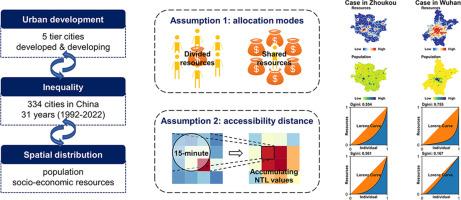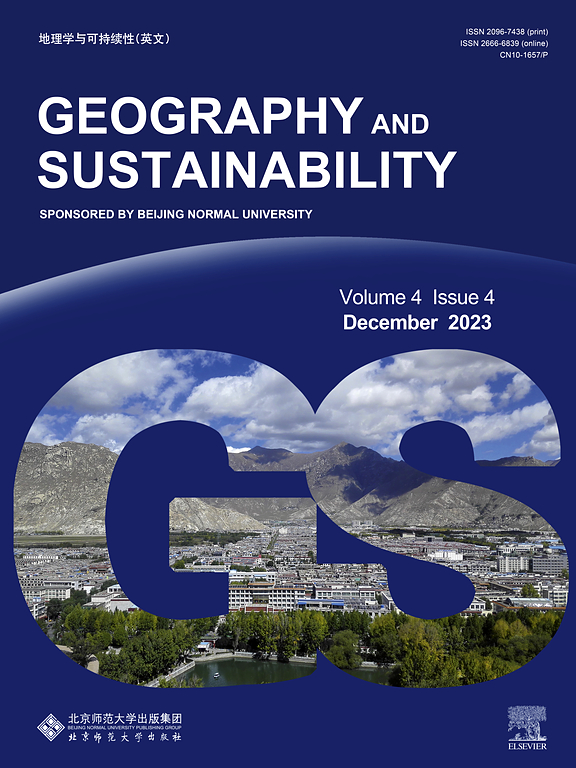中国15分钟城市社会经济资源分配与共享的不平等
IF 8
1区 环境科学与生态学
Q1 GEOGRAPHY, PHYSICAL
引用次数: 0
摘要
社会经济资源的不平等威胁到个人福利和城市的可持续性。然而,不同资源配置情景下的不平等程度尚不清楚,且未考虑到资源的可达距离。在过去31年(1992-2022年)的15分钟城市中,我们开发了一个大规模、长期、多角度的资源分配和资源共享情景不平等定量评估框架。这一框架以城市发展模式以及资源和人口的空间分布为依据。来自中国334个城市的研究结果表明,发达城市和发展中城市的不平等程度存在差异。当个体在15分钟可达距离内共享资源时,由于资源在空间上更为平衡,发达城市的不平等程度低于发展中城市,且在过去31年中呈下降趋势。然而,由于发达城市人口空间分布的不均衡,当资源在15分钟可达距离内分配时,个体之间的不平等加剧。建议政府通过合理化社会经济资源的空间配置,避免政策滞后,减少不平等现象。发达城市可以采取政策引导城市中心的过剩人口向外转移,发展中城市应该关心郊区居民的资源。本文章由计算机程序翻译,如有差异,请以英文原文为准。

Inequality of divided and shared socio-economic resources in 15-minute cities of China
The inequality of socio-economic resources has threatened individual well-being and urban sustainability. However, the inequality in different resource allocation scenarios is still unclear, and the accessibility distance to resources has not been considered. We developed a large-scale, long-term, and multi-perspective quantitative evaluation framework of inequality in the dividing-resource and sharing-resource scenarios over the past 31 years (1992–2022) within 15-minute cities. This framework is informed by patterns of urban development and the spatial distribution of resources and population. The results from 334 Chinese cities demonstrate the differences in inequality between developed and developing cities. When individuals share resources within 15-minute accessibility distance, inequality is lower in developed cities relative to developing cities due to more spatially balanced resources, with a decreasing trend over the past 31 years. However, due to the uneven spatial distribution of the population in developed cities, inequality among individuals has increased when resources are divided within 15-minute accessibility distance. We suggest that the government avoid policy lagging and reduce inequality by rationalizing the spatial configuration of socio-economic resources. Developed cities could adopt policies to direct the overpopulation of city centers outward, and developing cities should care about resources for suburban citizens.
求助全文
通过发布文献求助,成功后即可免费获取论文全文。
去求助
来源期刊

Geography and Sustainability
Social Sciences-Geography, Planning and Development
CiteScore
16.70
自引率
3.10%
发文量
32
审稿时长
41 days
期刊介绍:
Geography and Sustainability serves as a central hub for interdisciplinary research and education aimed at promoting sustainable development from an integrated geography perspective. By bridging natural and human sciences, the journal fosters broader analysis and innovative thinking on global and regional sustainability issues.
Geography and Sustainability welcomes original, high-quality research articles, review articles, short communications, technical comments, perspective articles and editorials on the following themes:
Geographical Processes: Interactions with and between water, soil, atmosphere and the biosphere and their spatio-temporal variations;
Human-Environmental Systems: Interactions between humans and the environment, resilience of socio-ecological systems and vulnerability;
Ecosystem Services and Human Wellbeing: Ecosystem structure, processes, services and their linkages with human wellbeing;
Sustainable Development: Theory, practice and critical challenges in sustainable development.
 求助内容:
求助内容: 应助结果提醒方式:
应助结果提醒方式:


